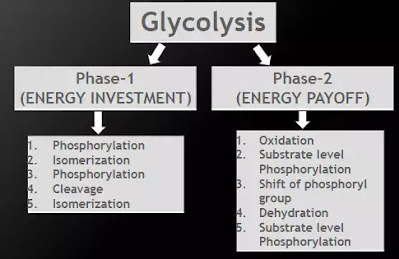Glycolysis
Glycolysis is the breakdown of glucose molecules into pyruvate.
Glucose can produce many things like polysaccharides, glycogen starch glucose, ribose-5-phosphate and pyruvate but only the conversion of glucose into pyruvate is known as glycolysis.
The
process of glycolysis occur in different ways like;
·
It carried out in nearly every living cell
specially in the cytosol of eukaryotic cell.
·
It release energy which is stored in covalent bond.
·
It undergoes in stepwise degradation in glucose and
other simple sugars.
Overview
of Glycolysis:
Process of glycolysis occur in two
phases.
·
Phase
1 is Energy Investment Phase
· Phase 2 is Energy payoff Phase
These two phases of glycolysis occur in ten
(10) different reaction. Reaction 1-5 are energy investment phase and reaction
6-10 are energy payoff phase.
 |
| Glycolysis |
Phase-1: Energy Investment Phase
STEP-1: PHOSPHORYLATION:
·
Glycolysis
take place in cytosol of cell.
·
Glucose
enter into the glycolysis pathway by conversion to glucose-6-pathway.
·
Initially
there is energy input corresponding to cleavage of two ~P bonds of ATP.
·
Kinase
is the enzyme that catalyzes the phosphorylation of molecules using ATP.
Step-1: Phosphorylation
 |
| Phosphorylation |
STEP-2: ISOMERIZATION:
“Phosphohexose Isomerase” is an enzyme that
catalyze the transformation of compound in their positional isomers. In the
case of sugar this usually involves the interconversion of an aldose sugar into
ketose sugar or vice versa.
Step-2: Isomerization:
 |
| Isomerization |
STEP-3: PHOSPHORYLATION:
Phosphofructokinase is the enzyme that catalyze the transformation of fructose-6-phosphate into fructose-1,6-bisphosphate. By the phosphorylation, the ATP molecule will convert into the ADP molecule.
 |
| PHOSPHORYLATION |
STEP-4: CLEAVAGE:
·
In
the cleavage step, fructose-1,6-bisphosphate will convert into the
Dehydroxyacetone phosphate and glyceraldehyde-3-phosphate.
· This reaction is an aldose cleavage reaction, the reverse of an aldose condensation.
· Carbon atoms are renumbered in the product of Aldolase.
·
STEP-5:
ISOMERIZATION:
·
The
enzyme “Trios phosphate isomerase” catalyzes Dehydroxyacetone phosphate into
Glyceraldehyde-3-phosphate.
·
Phase-2: Energy Payoff Phase
·
STEP-6: OXIDATION:
Glyceraldehyde-3-phosphate and NAD+ and 1-phosphate
molecule will be convert into 1,3-bisphosphoglycerate and NADH And one proton
molecule by the action of enzyme “Glyceraldehyde-3-phosphate dehydrogenase”.
STEP-7: SUBSTRATE LEVEL PHOSPHORYLATION:
·
The
enzyme “Phosphoglycerate Kinase” catalyzes the 1,3-bisphosphoglycerate and ADP
into 3-phosphoglycerate and ATP.
·
This phosphate transfer is irreversible.
·
STEP-8: SHIFT
OF PHOSPHORYL GROUP:
·
The
enzyme “Phosphoglycerate Mutase” catalyzes the 3-phosphoglycerate into
2-phosphoglycerate.
· Mutase is actually an enzyme that catalyze the transposition of functional group, such
as phosphate, sulphate etc.
STEP-9: DEHYDRATION:
·
The
enzyme “Enolase” catalyzes the 2-phosphoglycerate into phosphophenolpyruvate
and water molecule.
· This dehydration reaction is Mg+ dependent.
·
STEP-10: SUBSTRATE LEVEL PHOSPHORYLATION:
·
The
enzyme “Pyruvate Kinase” catalyzes the phosphophenolpyruvate and ADP into
Pyruvate and ATP.






0 Comments
Thanks You....